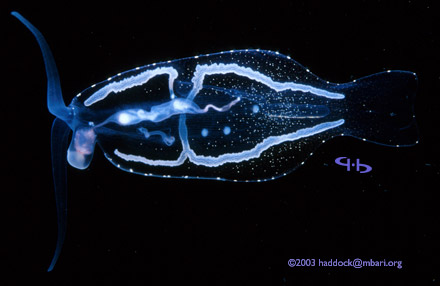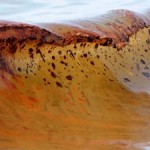
From Bioluminescence Web Page: Nudibranchs are not generally thought of as bioluminescent organisms, but this pelagic form Phylliroe has the ability to produce light. (The head is on the left). (Length approx. 7 cm) See the SeaSlug Forum for more information
It has been a long time coming, but at last #16 is here! As I began to write this post, I soon realized that someone else had already compiled (and much better) the information on the web. Steve Haddock, Bioluminescent Expert Extraordinaire, maintains the Bioluminescence Web Page, which is chock-a-block full of information. Head on over to learn more. Make sure you hit the mailbag and the photo page. Below is list of interesting factoids, from the webpage, to impress your dinner guests with.
- Bioluminescence is light produced by a chemical reaction which originates in an organism.
- Bioluminescence is a primarily marine phenomenon. In contrast, bioluminescence is essentially absent in fresh water.
- Bioluminescence has evolved many times in the sea as evidenced by the several distinct chemical mechanisms by which light is emitted and the large number of only distantly related taxonomic groups that have many bioluminescent members.
- Bioluminescence is not the same as “fluorescence” or “phosphorescence”. In fluorescence, energy from a source of light is absorbed and re-emitted as another photon. In bioluminescence or chemiluminescence the excitation energy is supplied by a chemical reaction rather than from a source of light.
- At least two chemicals are required. The one which produces the light is generically called a “luciferin” and the one that drives or catalyzes the reaction is called a “luciferase.”
- Almost all marine bioluminescence is blue in color, for two related reasons. A notable exception to this “rule” is Malacosteid family of fishes (known as Loosejaws), which produce red light and are able to see this light when other organisms can not.
Share the post "25 Things You Should Know About the Deep Sea: #16 Bioluminescence is the predominant source of light in the deep."



